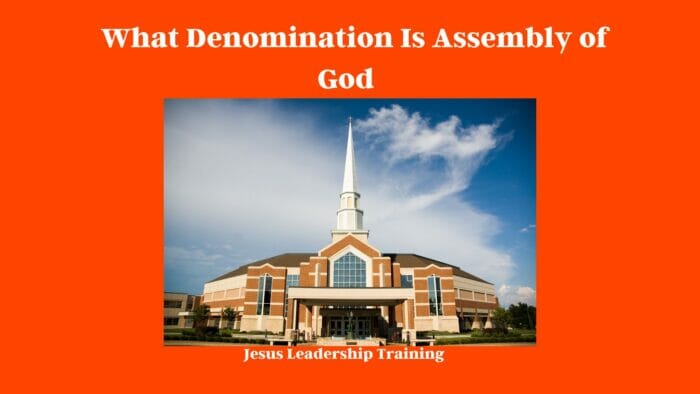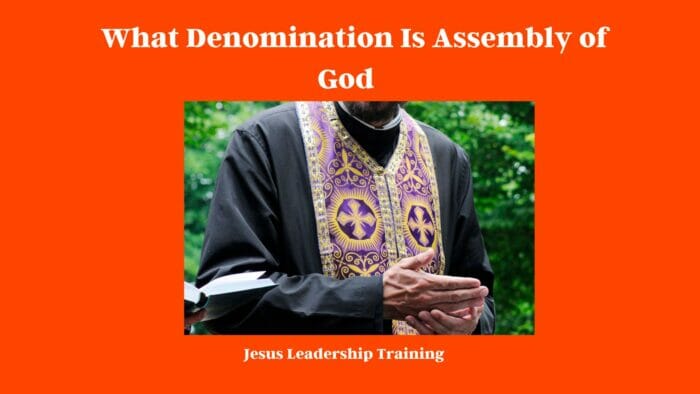What Denomination Is Assembly of God – Discover the denomination of the Assembly of God, its core beliefs, practices, and the significance of its faith within Christianity. Learn more about the Assembly of God’s doctrines, worship style, and organizational structure.
The Assembly of God is a prominent Christian denomination that has gained recognition worldwide. With its emphasis on evangelism, charismatic worship, and belief in the supernatural gifts of the Holy Spirit, the Assembly of God has attracted a large following.
In this article, we will delve into the question, “What denomination is Assembly of God?” and explore the beliefs and practices that distinguish this denomination within Christianity. From its origins to its organizational structure, doctrines, and worship style, we will provide a comprehensive overview of the Assembly of God.
Table of Contents
What Denomination Is Assembly of God?
The Assembly of God is a Pentecostal denomination within Christianity. Pentecostalism, originating from the early 20th century, emphasizes a personal experience of the Holy Spirit and the manifestation of spiritual gifts, such as speaking in tongues, prophecy, and healing. The Assembly of God is one of the largest Pentecostal denominations globally, with millions of members worldwide.
The Enlightening Journey: Unraveling the History and Origin of the Assemblies of God
Meta-description: Take a deep dive into the intriguing journey of the Assemblies of God, tracing its history, and origin. Explore how this Pentecostal movement shaped a unique spiritual landscape across the globe.
Introduction: A Journey Back in Time
Before we hit the road, let’s take a minute to pack our mental bags for the journey ahead. We’re about to dive headfirst into a riveting tale that stretches over a century, crisscrossing continents and drawing together countless individual stories into one grand narrative. Hold onto your hats, folks; we’re taking an excursion into the fascinating History and Origin of the Assemblies of God.

I. The History and Origin of the Assemblies of God: The Genesis
Unraveling the roots of any movement can be quite a task, and the Assemblies of God is no exception. We must turn back the clock to the dawn of the 20th century, an era steeped in change.
A. The Azusa Street Revival: The Spark that Ignited the Flame
The Assemblies of God found its birth in the Pentecostal movement, which was born from the embers of the Azusa Street Revival in Los Angeles (1906-1915). This powerful spiritual event, led by William J. Seymour, a black minister, was a beacon of racial integration and charismatic worship. It caught like wildfire, and soon, similar gatherings sprouted up across the United States and beyond.
B. A Desire for Unity: The Call for an Assembly
Fast forward to 1914. Despite the rapid expansion of the Pentecostal movement, it was a fragmented landscape of independent churches with little cohesion. In response to this, leaders felt a pressing need for unity and organization, and thus, they issued a call for an assembly. This call marked the conception of the Assemblies of God.

II. The Birth of the Assemblies of God: Setting a Course
A. The First General Council: Crafting a Shared Identity
In April 1914, hundreds of Pentecostal ministers flocked to Hot Springs, Arkansas, to attend the first General Council. This momentous meeting led to the official formation of the Assemblies of God, marking a significant milestone in the history of this movement. During this council, they outlined their Fourfold Gospel and adopted a Statement of Fundamental Truths.
B. The Early Challenges: Doctrine and Governance
However, the newborn Assemblies of God was not without its growing pains. The fledgling organization had to navigate a myriad of challenges, such as the Oneness controversy and establishing a structure for church governance. Yet, these hurdles only served to strengthen and clarify the identity of the Assemblies of God.
III. The Assemblies of God: Growth and Expansion
As we continue our journey, we find that the Assemblies of God, once established, began to spread its wings and take flight.
A. The Flourishing of a Movement: Domestic Growth
In the decades following its establishment, the Assemblies of God experienced significant growth within the United States. As it grew, the denomination diversified its ministries, establishing Bible schools, youth organizations, and missionary training programs.

B. Beyond Borders: The Birth of World Missions
From its early days, the Assemblies of God had a keen eye on the international scene, and this vision led to the creation of the World Missions initiative in 1919. Since then, the Assemblies of God has left footprints across the globe, transforming into a truly international fellowship.
IV. The Assemblies of God in the Modern Era: Reshaping and Adapting
As we near the end of our historical tour, we find the Assemblies of God not stuck in the past but evolving to meet the demands of a changing world.
A. Navigating Changing Cultural Landscapes
From the Civil Rights Movement to the Digital Revolution, the Assemblies of God has witnessed numerous societal transformations. Yet, it has continually adapted its methods without compromising its core beliefs, a testament to the resilience and relevance of this fellowship.
B. Embracing Diversity: The Multiplication of Voices
In the modern era, the Assemblies of God has made strides in embracing diversity. Women and ethnic minorities have risen to leadership roles, and international voices have become an integral part of the General Council’s discussions, reflecting the truly global nature of this fellowship.
V. The Future of the Assemblies of God: Gazing into the Horizon
The Assemblies of God stands on the threshold of its second century, and the future looks promising.
A. A New Generation: Youth and the Assemblies of God
The Assemblies of God has a vibrant youth culture, a promising sign for the future. Youth-focused initiatives like the Royal Rangers and the National Fine Arts Festival serve as platforms to engage and inspire the next generation of leaders.
B. The Global Vision: International Fellowship and Cooperation
The Assemblies of God looks to the future with a global vision, striving to foster closer ties with its international counterparts. Together, they aim to spread the message of the Fourfold Gospel even further, making an impact in more communities worldwide.
FAQs
- When was the Assemblies of God formed?
The Assemblies of God was officially formed during the first General Council held in April 1914 in Hot Springs, Arkansas. - What is the Fourfold Gospel?
The Fourfold Gospel is the central belief of the Assemblies of God, emphasizing Jesus as Savior, Healer, Baptizer in the Holy Spirit, and Soon-coming King. - What is the World Missions initiative?
The World Missions initiative, established in 1919, is the Assemblies of God’s commitment to fulfilling the Great Commission by supporting missionaries worldwide. - Are there Assemblies of God churches outside the U.S.?
Yes, the Assemblies of God is a global fellowship with churches in over 200 countries. - What is the National Fine Arts Festival?
The National Fine Arts Festival is a youth event by the Assemblies of God, aiming to develop their artistic skills and encourage their spiritual growth. - Who can become a member of the Assemblies of God?
Anyone who professes faith in Jesus Christ and accepts the beliefs and practices of the Assemblies of God can become a member.
Beliefs of the Assembly of God
The Assembly of God holds several core beliefs that shape its identity as a denomination. These beliefs include:
- The Bible as the Inspired Word of God: The Assembly of God views the Bible as the infallible and authoritative Word of God, providing guidance for faith and practice.
- The Trinity: The Assembly of God believes in the triune nature of God, consisting of the Father, Son (Jesus Christ), and Holy Spirit.
- Salvation through Jesus Christ: The Assembly of God affirms that salvation is obtained through faith in Jesus Christ, who died for the forgiveness of sins and rose from the dead.
- Baptism in the Holy Spirit: The Assembly of God places great importance on the baptism in the Holy Spirit as a distinct experience subsequent to salvation, accompanied by the evidence of speaking in tongues.
- Divine Healing: The Assembly of God believes in the healing power of God and recognizes prayer for healing as an integral part of their faith.
- The Bible: The Assemblies of God believes that the Bible is divinely inspired by God and is the authoritative source of truth. The Bible is the final authority in all matters of faith and practice. (2 Timothy 3:16-17)
- God: The Assemblies of God believes in one sovereign God who eternally exists in three persons; Father, Son, and Holy Spirit. (Genesis 1:26; Matthew 28:19; 2 Corinthians 13:14)
- Jesus Christ: The Assemblies of God believes that Jesus Christ is the only begotten Son of God, conceived of the Holy Spirit, born of the virgin Mary, and is God in human form. (John 3:16; Acts 1:9; Hebrews 1:3)
- Salvation: The Assemblies of God believes that salvation is available to all through faith in Jesus Christ. (Romans 10:9-10; Ephesians 2:8-9)
- Baptism in the Holy Spirit: The Assemblies of God believes that baptism in the Holy Spirit is available to all believers and is evidenced by speaking in tongues. (Acts 2:4; Acts 10:46; Acts 19:6)
- Spiritual Gifts: The Assemblies of God believes that the spiritual gifts are available to believers and should be eagerly desired and exercised. (1 Corinthians 12:1-11; Romans 12:6-8; 1 Peter 4:10)
- Sanctification: The Assemblies of God believes in a progressive sanctification which leads to a life of holiness. (Hebrews 12:14; Romans 6:19-22)
- The Church: The Assemblies of God believes that the church is the body of Christ and consists of all believers. (Ephesians 1:22-23; Ephesians 5:25-27)
- Divine Healing: The Assemblies of God believes that divine healing is available to all believers through the power of the Holy Spirit. (James 5:14-16; Mark 16:18; 1 Peter 2:24)
- The Second Coming of Christ: The Assemblies of God believes that Jesus Christ will return to earth in power and glory. (Matthew 24:30; Revelation 19:11-16)
Doctrines and Practices – Baptism
The Assembly of God adheres to a set of doctrines and practices that guide its worship and community life. These include:
- Divine Healing Services: The Assembly of God often conducts special services focused on prayer for healing. These services may involve laying on of hands, anointing with oil, and fervent prayer for physical, emotional, and spiritual healing.
- Baptism by Immersion: The Assembly of God practices baptism by immersion, symbolizing the believer’s identification with the death, burial, and resurrection of Jesus Christ.
- Emphasis on Evangelism: Evangelism is a central focus of the Assembly of God. The denomination encourages its members to actively share their faith and engage in missionary work.
- Charismatic Worship: The Assembly of God embraces expressive and vibrant worship styles, characterized by contemporary music, spontaneous prayers, and an openness to the manifestation of spiritual gifts.
- Youth and Children’s Ministries: The Assembly of God places great importance on nurturing the faith of young people. The denomination has robust youth and children’s ministries, providing age-appropriate programs and events to help them grow spiritually.
Organizational Structure of the Assembly of God
The Assembly of God operates under a hierarchical structure that facilitates governance and decision-making. Key elements of its organizational structure include:
- Local Churches: The Assembly of God consists of individual local churches that have autonomy in their day-to-day operations. Each church is led by a pastor and governed by a board of elected officials.
- District Councils: Local churches are grouped together into districts, which are overseen by district councils. District councils provide leadership, support, and resources to the churches within their jurisdiction.
- General Council: The General Council is the highest governing body of the Assembly of God. It comprises elected representatives from the districts and is responsible for setting policies, doctrines, and overseeing the denomination as a whole.
Frequently Asked Questions (FAQs)
- Q: What is the history of the Assembly of God? A: The Assembly of God traces its roots back to the early 20th century, beginning in Hot Springs, Arkansas, in 1914. It emerged from the Pentecostal revival and has since grown into a global denomination.
- Q: Are speaking in tongues and divine healing essential beliefs of the Assembly of God? A: Yes, the Assembly of God considers speaking in tongues and divine healing as important aspects of their faith, rooted in their interpretation of biblical teachings.
- Q: Is the Assembly of God involved in social and humanitarian efforts? A: Yes, the Assembly of God actively participates in social and humanitarian initiatives, such as disaster relief, community development projects, and support for missions around the world.
- Q: Can anyone attend an Assembly of God church? A: Yes, Assembly of God churches welcome individuals from all walks of life to attend their services and participate in their activities, regardless of their background or beliefs.
- Q: Is the Assembly of God denomination present globally? A: Yes, the Assembly of God has a significant presence worldwide, with churches in numerous countries across all continents.
- Q: Can women hold leadership positions in the Assembly of God? A: Yes, the Assembly of God allows women to serve in various leadership roles, including pastors, evangelists, teachers, and missionaries.
Final Thoughts – What Denomination Is Assembly of God
The Assembly of God is a dynamic Pentecostal denomination with a strong emphasis on the Holy Spirit, evangelism, and charismatic worship. Its beliefs, practices, and organizational structure distinguish it within the larger framework of Christianity. By understanding the Assembly of God’s core doctrines and examining its worship style, we can gain insight into the denomination’s significance within the global Christian community.




